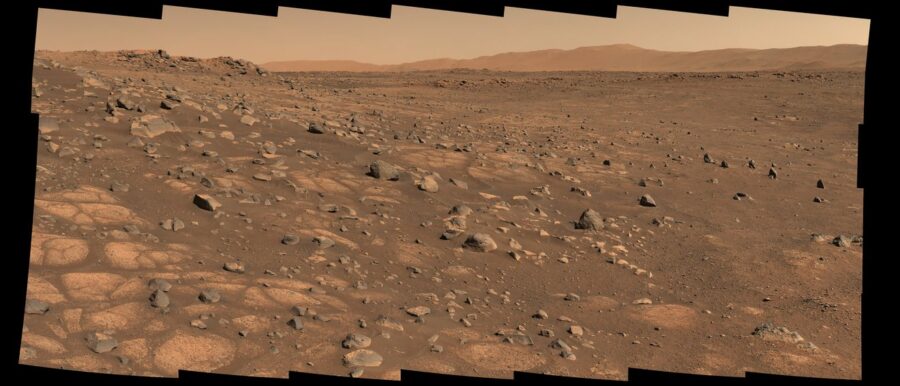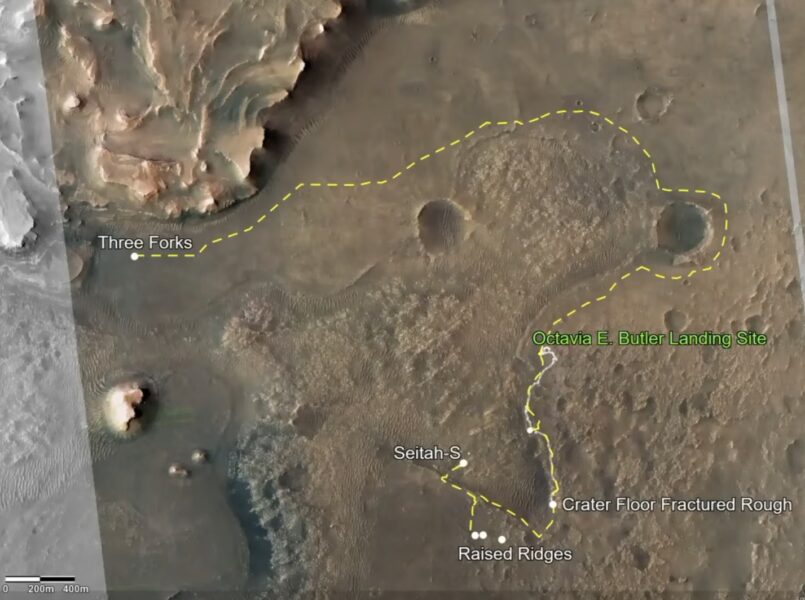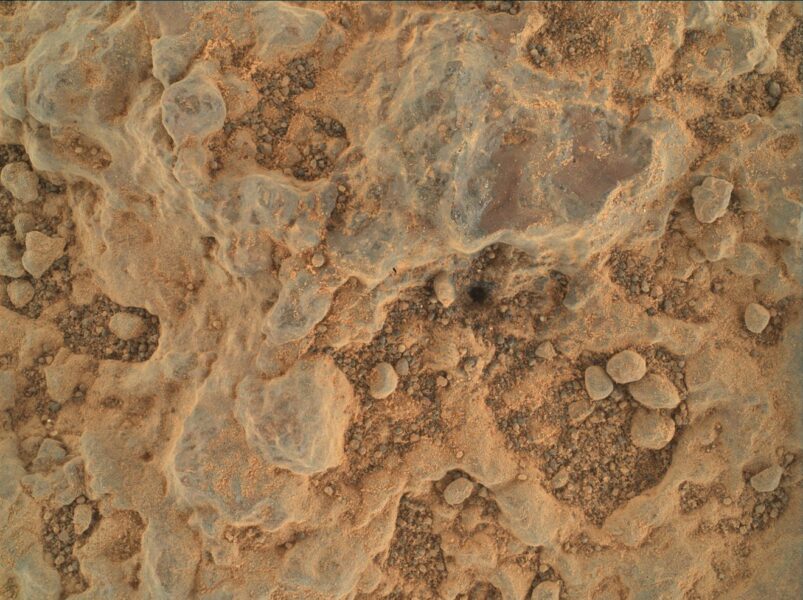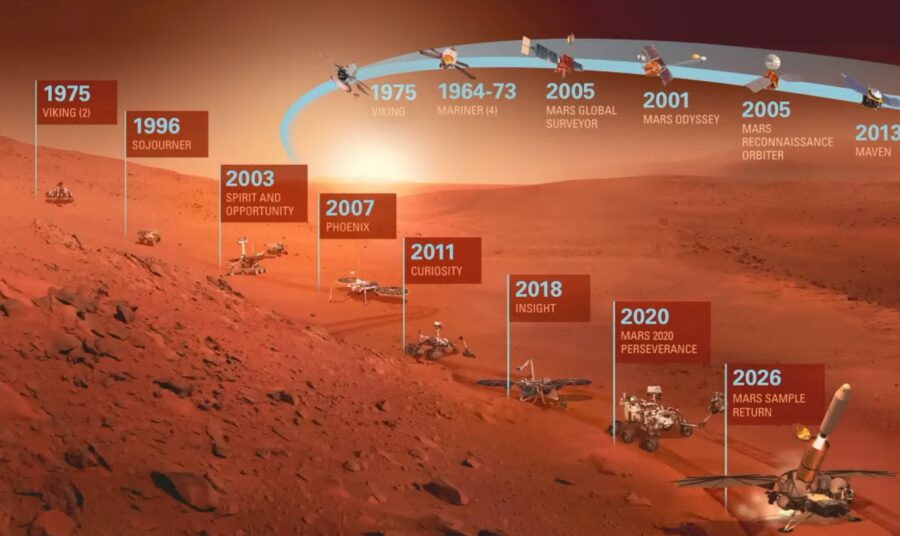Perseverance will soon collect the first of many samples from the Martian surface in a quest to answer whether the planet once hosted life.

NASA / JPL-Caltech / ASU / MSSS
After several months on the Martian surface, NASA scientists announced today that the Perseverance rover is about to begin its primary mission in Jezero Crater. Skirting the Séítah sand dunes, the rover will soon collect its first of several samples of Martian regolith.
“When Neil Armstrong took the first sample from the Sea of Tranquility 52 years ago, he began a process that would rewrite what humanity knew about the Moon,” says associate administrator Thomas Zurbuchen (NASA) in a recent press release. “I have every expectation that Perseverance’s first sample from Jezero Crater, and those that come after, will do the same for Mars.”
Perseverance landed in Jezero Crater on February 18, 2021, and has since scouted out its new home, flexed its instruments, and deployed the Ingenuity helicopter, which has kept pace via short hopping flights. To date, the rover has traveled 1.48 kilometers (0.92 miles). Now, unlike missions before it, Perseverance aims to address the question of whether Mars once hosted life, back when Jezero held a lake within its crater walls, and the samples it collects will play a big part in that.
The First Sample

NASA / JPL-Caltech
Perseverance will collect its first sample from a site named Cratered Floor Fractured Rough in Three Forks, an ancient outflow delta. One crucial question the site poses is whether the flat "paver stones" are igneous (volcanic) or sedimentary — if igneous , Earthbound geologists could date the rocks with a high degree of accuracy.
“While the rocks located in this geologic unit are not great time capsules for organics, we believe they have been around since the formation of Jezero Crater and incredibly valuable to fill gaps in our geologic understanding of this region,” says Perseverance project scientist Ken Farley (Caltech).

NASA / JPL-Caltech
Before caching its first sample, Perseverance will first survey the primary target location along with a separate target site in the same area. “The idea is to get valuable data on the rock we are about to sample by finding its geologic twin and performing detailed, in-situ analysis,” explains Vivian Sun (NASA/JPL).
Perseverance will first use tools to scrape the geologically similar rock's surface and blow it clean. Then it will investigate it using the instruments on the end of its 2-meter (7-foot) mechanical arm, including SHERLOC (Scanning Habitable Environments with Raman & Luminescence for Organics & Chemicals), PIXL (Planetary Instrument for X-ray Lithochemistry), and WATSON (Wide Angle Topographic Sensor for Operations and eNgineering).
PIXL, which consists of an X-ray spectrometer and up-close camera designed to resolve fine-scale composition of soil samples, will produce chemical composition maps that scientists will consider hand-in-hand with the mineral maps made by the SHERLOC laser spectrometer, and the views provided by the WATSON color camera.

NASA / JPL-Caltech / MSSS
The rover’s Mastcam-Z and Supercam instruments will also get in on the action. Specifically, Mastcam-Z will capture high-resolution imagery as SuperCam fires its laser at the abraded surface and measures the spectrum of the resulting plume.
“After our pre-coring science is complete, we will limit rover tasks for a sol, or a Martian day,” Sun adds.
Then, Perseverance will return to the untouched geological "twin" and collect a core sample about the size of a human finger. It will seal the tube and store it in the rotary Adaptive Caching Assembly, billed as the "cleanest piece of equipment ever sent into space." Eventually, Perseverance will place the tubes on the surface for future retrieval. There are 43 sample tubes on Perseverance, and the goal is to fill at least 20 from four separate sites.
The first sample collection is expected to take about 11 days, taking place in the first few weeks of August. Already, Perseverance has opened and stowed the first of five "witness tubes." Each of these tubes comes preloaded with various materials, and when they're opened on Mars they "witness" the ambient environment near the collection site. These tubes basically act as controls, to be returned to Earth along with the Martian samples, that will help scientists determine if there were Earth contaminants present during sample collection.

NASA / JPL-Caltech
The ultra-clean sample collection tubes will be stowed along with the witness tubes at a to-be-determined location for a separate lander–ascent vehicle mission to collect and return them to Earth. Last year, NASA awarded Northrop-Grumman the contract to build the propulsion system and control for the Mars ascent-return vehicle.
Expect the launch and sample return to occur somewhere in the 2026-2028 timeframe, returning to Earth in the early-2030s. Perseverance's primary mission will last 1 Martian year (687 Earth days, 669 sols), but if it continues on, it might even witness the sample return landing nearby.

NASA/JPL-Caltech
Perseverance is the key link between exploring the Martian surface and collecting and returning Martian samples to labs on Earth — a process that is now underway.
 0
0









Comments
You must be logged in to post a comment.